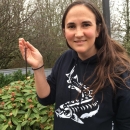Across their native range, many lamprey species have declined in distribution and abundance (Close et al., 2002; Maitland et al., 2015; Clemens et al., 2017, 2021). For all lamprey species, the life cycle includes a multi-year larval stage during which they burrow into fine sediments for up to ten years (Hess et al. 2022) and feed on algae, bacteria, and organic detritus in freshwater habitats (Dawson et al. 2015; Evans et al. 2019). Native lampreys are important fishes in freshwater ecosystems. Research suggests larval lampreys alter the physical and chemical environment of the benthic community (Shirakawa et al. 2013; Boeker and Geist 2016; Nika et al. 2021), aid in filtration of harmful bacteria out of the water column (Kalan et al. 2023), and act as a vital food source for aquatic and terrestrial predators (Cochran 2009; Arakawa and Lampman 2020). The extent that outmigrating juvenile lamprey act as a predation buffer has not been assessed, but it is thought to be significant. Anadromous adult lampreys are especially important in freshwater ecosystems because they modify communities when building redds, and their carcasses supply marine-derived nutrients (Hogg et al. 2014; Weaver et al. 2016, 2018; Dunkle et al. 2021; Georgakakos 2020).
The Columbia River Estuary Study Taskforce and the U.S. Army Corps of Engineers (USACE) are collaborating to evaluate potential benefits associated with strategic placement of dredged material, also known as “beneficial use”. Their goal with beneficial use is to expand and restore shallow water habitats (USACE 2020). Eighty percent of dredged material is placed back into the river and yet effects of the dredged material placement (including beneficial use) on the density, distribution, and survival of larval lampreys have not been assessed. Likewise, there are no regulatory requirements to assess entrainment of any fishes, freshwater mussels, or other aquatic organisms during dredging operations in the Columbia River. The goals of this work were to initiate monitoring of lamprey relative to dredging and placement of dredged materials and to learn about the extent of use of the Woodland Island area by larval lampreys.




